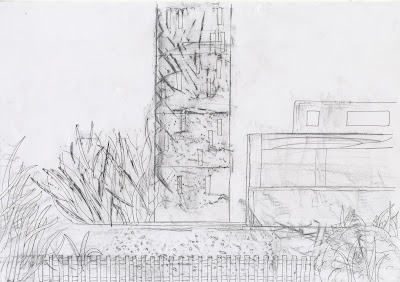For my first methodology I looked at the technique. This is where you spread thick paint onto paper or canvas, then apply some paper or a material to leave texture and marks within the paint, and this then becomes the base of the painting.
“Decalcomania images are often produced in rapid succession without any forethought. The most beautiful ones - those that suggest more than mere stampings - can offer the artist unique textures obtainable in no other way.” (1)
Similar to this image of the detail of Max Ernst’s painting (2), I tried to create an image which gives greater and abstract detail to the landscape than a usual painting.
I used this technique with green and yellow paint and I thought that it looked like a forest, with the pathway in the middle and trees towering above. I added detail with leaves to the top of the trees to make it appear more like how I wanted. I think I’ve created something that is very expressive and flows well, something that is less easily created when painting with an image in mind.
For my second methodology I looked into Frottage, this is where you take a drawing tool and make rubbings over various textured surfaces. This may be the ending of the drawing but it can also be used to interpret various pictures within the rubbings to create a further illustration. This technique was developed in drawings from 1925 by Max Ernst (3) when he noticed strange images in the patterns within the wooden floor.
This is one of the pieces created by Max Ernst’s rubbings, a common theme for his art is the use of trees.(4) The rustic and free flowing look of this is created by overlapping various rubbings he has collected.
I rubbed my paper on some various textured things around the studio and immediately saw a few buildings being some bushy landscape. So i drew into this a little bit to make what i saw in it more obvious.
For the third methodology, I wanted to look at Creature concept art. I found this artist, Aaron Blaise (5) who favours creating different unique creatures by merging aspects of animals together. He sometimes merges so many aspects that you cant even tell what animals he took parts from anymore, but this example shows one that is very obvious for an example.
For this, I wanted to just do a very simple experiment and so I played the ‘Exquisite Corpse’ game with a couple of friends. This is where you fold the pages and each person draws an aspect of a creature without seeing the other folded over parts.
I think this is a great way of showing how easy and simple it is to create an abstract creature. It doesn't fit together but it would be a great starting point to expand on and to gain ideas for your random creature.
For the last methodology, I looked into H R Gigers biomechanical art. He is well known for designing humans and machines linked together within a strange relationship to create a whole new form. Giger was heavily influenced by surrealism, and used this to expand on his own work. He calls this style of work ‘biomechanical’ and described it as “biomechanical aesthetic, a dialectic between man and machine, representing a universe at once disturbing and sublime.” (6)
I looked at his work and found this piece, which was the cover for the book, “Gigers Alien”. This is a very iconic image that is well known for being in the film ‘Alien’. I thought this represents well, the dark imagery of nightmares that he creates.
I then found this piece (7), which i thought really represented his biomechanical art well, as it shows the creepy dark side, but also the sexual aspect to it that he uses within his work. And so this is what inspired me to create my own biomechanical creature.
I used the sexualised nature of his work, to get the starting point of the posing girl. I then added mechanical like features to torso and legs. The small mask to hide her face was to make her appear even less human like, and I used big bold hair which features in his own work a lot. I think i have created the same relationship of humans and machines that H R Giger does.
References
(1) Decalcomania-Art techniques, (2004)
(2) Phillipe, (2014)
(3) Tate, Frottage
(4) Max Ernst, The forest
(5) Aaron Blaise, The art of Aaron Blaise
(6) Holmes, (2012)
(7) H. R Giger
Bibliography
Blaise, A. (no date) The art of Aaron Blaise. Available at: https://creatureartteacher.com/conceptcharacter-art-gallery/ (Accessed: 30 November 2015).
Collection online | Max Ernst. The forest (la forêt). 1927–28 - Guggenheim museum (2015) Available at: http://www.guggenheim.org/new-york/collections/collection-online/artwork/1133 (Accessed: 30 November 2015).
Coolvibe (2010) Surreal art by H.R Giger, creator of ‘alien’. Available at: Coolvibe.com/2010/surreal-art-by-h-r-Giger-creator-of-alien-2/ (Accessed: 30 November 2015).
Decalcomania - Art Techniques (2004) Available at: http://www.arttalk.com/archives/vol-15/artv1502-1.htm (Accessed: 30 November 2015).
Frottage (no date) Available at: http://www.tate.org.uk/learn/online-resources/glossary/f/frottage (Accessed: 30 November 2015).
Holmes, K. (2012) ‘Original creators: Biomechanical Surrealist H.R.Giger’, The creators project , 12 November. Available at: thecreatorsproject.vice.com/en_uk/blog/original-creators-biomechanical-surrealist-hrgiger (Accessed: 30 November 2015).
Phillipe, B. (2014) ‘Alice in 1941 by Max Ernst’, My French Easel, 31 January. Available at: myfrencheasel.blogspot.co.uk/2014/01/alice-in-1941-by-marx-ernst.html (Accessed: 30 November 2015).









No comments:
Post a Comment